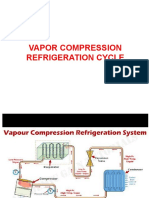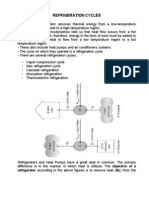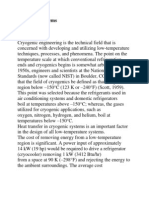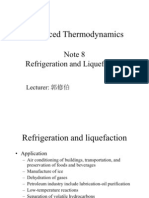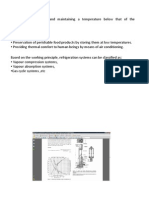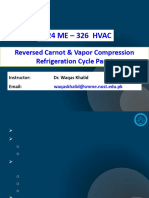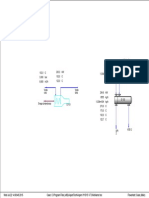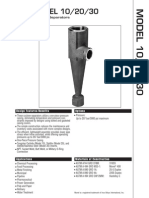Refrigeration & Liquefaction
Uploaded by
overlord5555Refrigeration & Liquefaction
Uploaded by
overlord5555Refrigeration
&
Liquefaction
Outline
Recuperative systems
Ideal refrigeration / liquefaction
Joule Thomson expansion
System analyses: 1st and 2nd law applied
to:
Simple Linde-Hampson cycle
Variations and improved performance cycles
Claude and Collins cycles
Ideal Refrigeration/Liquefaction
Moving heat from a cold reservoir to a warm reservoir
requires energy
dW
dQ
c
dQ
h
In an ideal process, the entropy associated with the
two heat flows is the same, that is:
The amount of heat moved is associated with an
amount of entropy by the relationship:
In an ideal process the amount of work (energy) required
to move the heat is
dW = dQ
h
dQ
c
Ideal Cool Down
Extracting an amount of heat to lower the temperature of
(whatever) by dT, and releasing the heat at T
h
:
Including the temperature dependence of the
specific heat, the ideal cool down work becomes:
Compare this to the amount of energy required to
warm up the same mass:
dQ dQ dQ dQ dQ dQ dQ
T
dQ/dT
dW/dT
Ideal Liquefaction
To cool down a parcel of gas, and convert it from saturated vapor to
saturated liquid at its normal boiling temperature:
Re-arranging terms we have:
Work to extract latent heat Work to extract sensible heat
Temperature dependent specific heat
Or, in the rate form:
Ideal Liquefaction
P
hig
h
T
S
Vapor dome
P
low
1
2
f
T
h
1
f
2
f
1st law: Energy balance around system:
In steady state, the sum of the energies into and out of the system = 0
A 1st-law,
2nd-law
analysis
around an
ideal cycle
reveals the
same
expression
2nd law: Entropy balance around system:
In steady state, the sum of the entropies into and out of the system = 0
Combining,we have:
0
Note the SI units of h(kJ/kg) and s(kJ/kg-K)
Ideal Refrigeration
In steady state, the 1st law around the
whole system gives:
1
3
2
4
The 2nd law around the compressor gives:
The 2nd law around the evaporator gives:
Combining, and noting that s
1
=s
4
and s
2
=s
3
we have:
The coefficient of performance (COP) for the refrigerator is then
Ideal Liquefaction / Refrigeration
Ideal liquefaction work for cryogens (from Barron)
Comparison with ideal performance defined by Figure of Merit (FOM), for
refrigeration sometimes referred to as % of Carnot.
Practical Limitations
Not possible to achieve ideal-
scenario pressure
Inspect T-S diagram: find lines of
constant pressure, constant
enthalpy, constant density, vapor
dome
Estimate required pressure for
ideal liquefaction of nitrogen
Isentropic expansion is very
difficult to achieve.
Isenthalpic (or throttle) expansion
is very easy to achieve
Cooling associated with throttle
process exploits real-gas
properties. Note that at high T,
low P, h is independent of
pressure, but elsewhere it is not.
Joule-Thomson Coefficient
1885 - Joule & Thomson (Lord Kelvin) confirm that a gas flow through a
restriction experiences a temperature drop along with the pressure drop.
!P
The Joule-Thomson coefficient: characterizes the phenomenon.
When
j
>0, cooling accompanies a pressure drop.
Regions of positive and negative
j
are reflected in T-S diagrams and
inversion curves:
T
S
h
p
low
T
c
p
c
p
high
Above the
inversion
temperature, we
have
j
< 0 for all
pressures.
Pre-cooling is
required for
helium (T
inv
=45K),
hydrogen (T
inv
=205K),
and neon (T
inv
=250K).
P/P
c
T/T
c
10-12
T
inv
j
>0
"T >0
j
< 0
"T
(p-1)
< 0
Simple Linde-Hampson Cycle
Inversion temperature must be above compression temperature, or pre-
cooling via a higher temperature refrigerant liquid is required.
Recuperative heat exchanger pre-cools high pressure stream.
Liquefier requires source of make-up gas.
Refrigerator absorbs heat converting liquid to vapor at saturation
temperature of low pressure.
Makeup
gas
m
Q
R
Compressor
Heat exchanger
Liquid
Liquid
reservoir
1
1
1
2 3
4 g
Joule -
Thomson
valve
f
m
f
W
Simple Linde-Hampson Cycle
In steady state conditions, the 1st
law around the compressor gives:
The 2nd law around the
compressor gives:
(Note the assumption of isothermal compression)
Combining, we have:
Applying the 1st law around everything except the compressor gives:
Defining yield, and combining with compression work gives:
Simple Linde-Hampson (JT) Refrigerator
Applying 1
st
law (energy
balance) to everything except
the compressor gives:
Makeup
gas
Compressor
Heat exchanger
Liquid
evaporator
1
1
1
2 3
4 g
Joule -
Thomson
valve
W
Combining with the expression
for the compressor work
provides an equation for the
COP:
Comparing with the Carnot COP gives the FOM (or % of Carnot):
Example: Linde-Hampson w/ Argon
Performance at 20 MPa:
" h
1
=
" h
2
=
" s
1
=
" s
2
=
Performance at optimized P
" h
2
=
" s
2
=
349 J/g
315 J/g
3.88 J/g-K
2.7 J/g-K
298 J/g
2.4 J/g-K
Linde-Hampson Performance
Optimum theoretical performance realized by minimizing h
2
(P
2
such
that h is on the inversion curve)
P
2
is typically ~ 100 atm.
Theoretical performance with P
2
= 20 atm.(from Barron):
Linde-Hampson Cycle Enhancements
Pre-cooled L-H cycle
Optimize performance via pressure,
pre-cooling temperature and mass
flow ratio
FOM increased by ~ factor of 2
Dual-pressure L-H cycle
Optimize performance via two
pressures and fractional mass flow
ratio
FOM increased by ~ factor of 1.9
(From Barron) (From Barron)
Claude Cycle: isentropic expansion
Isentropic expansion, characterized by
s
=dT/dP
s
(always >0) results in larger
temperature drop for a given pressure drop than with isenthalpic expansion
1st and 2nd law analyses give:
Optimize performance by varying P
2
, T
3
, and x.
Claude Cycle: Variations
Kapitza cycle
Low pressure (7 atm) production of
liquid air
Regenerative heat exchanger
Heylandt cycle
High pressure (200 atm) air
liquefaction
Room temperature expander
(From Barron) (From Barron)
Collins Liquefier
Introduced by Sam
Collins (MIT) in
1952
Optimized
performance via
expander flow rates
and temperatures
LN
2
pre-cooling
increases yield by
factor of 3.
(From Barron)
Commercial Helium Liquefier
The dashed line encloses
the cold box, i.e.
everything except the
compressor.
Find the expansion
engines
Trace the flow from LN
2
precooler through the
cold box to the JT valve.
Influence of Non-Ideal Components
A non-ideal heat exchanger will
have an effectiveness less than 1.
1
1
2
T
3
3
S
g
A non-isothermal compressor will require
more work than an isothermal
compressor
The influence of these non-ideal parameters on the cooling capacity
(refrigerator), liquid yield (liquefier), and compression work for a simple Linde-
Hampson system is:
You might also like
- Bailey's Industrial Oil and Fat Products, 6 Volume Set100% (5)Bailey's Industrial Oil and Fat Products, 6 Volume Set3,688 pages
- Chapter 5-Compounded Vapor Compression Cyclee-Examples100% (1)Chapter 5-Compounded Vapor Compression Cyclee-Examples65 pages
- 2A4 2nd Law of Thermodynamics Notes IrelandNo ratings yet2A4 2nd Law of Thermodynamics Notes Ireland67 pages
- “Foundations to Flight: Mastering Physics from Curiosity to Confidence: Cipher 4”: “Foundations to Flight: Mastering Physics from Curiosity to Confidence, #4From Everand“Foundations to Flight: Mastering Physics from Curiosity to Confidence: Cipher 4”: “Foundations to Flight: Mastering Physics from Curiosity to Confidence, #45/5 (1)
- Wed Jul 22 14:08:48 2015 Case: C:/Program Files (X86) /Aspentech/Aspen Hysys V7.3/Noname - HSC Flowsheet: Case (Main)No ratings yetWed Jul 22 14:08:48 2015 Case: C:/Program Files (X86) /Aspentech/Aspen Hysys V7.3/Noname - HSC Flowsheet: Case (Main)1 page
- Trend and Issue About End of Life in IcuNo ratings yetTrend and Issue About End of Life in Icu5 pages
- Participatory Action Research Literature Review100% (1)Participatory Action Research Literature Review7 pages
- Badri Engineering Corporation: One Stop Shop For All Your Industrial NeedsNo ratings yetBadri Engineering Corporation: One Stop Shop For All Your Industrial Needs2 pages
- 12 Physics Notes Ch01 Electric Charges and FieldNo ratings yet12 Physics Notes Ch01 Electric Charges and Field3 pages
- Placement Project BMIH6006.8 - Autumn Term 2023 Handbook FINAL KF EE PDFNo ratings yetPlacement Project BMIH6006.8 - Autumn Term 2023 Handbook FINAL KF EE PDF20 pages
- Q2 - M2 - Current and Future Trends in Media and InformationNo ratings yetQ2 - M2 - Current and Future Trends in Media and Information32 pages
- BSL Method Statememt For Lifting Thermal Tank - 1No ratings yetBSL Method Statememt For Lifting Thermal Tank - 14 pages
- Petroleum Engineering Course ArrangementNo ratings yetPetroleum Engineering Course Arrangement1 page
- Latinos and The Nation's Future Edited by Henry G. Cisneros and John Rosales100% (2)Latinos and The Nation's Future Edited by Henry G. Cisneros and John Rosales273 pages
- Material & Equipment Gate Pass Control No. 0005758641 Status: APPROVEDNo ratings yetMaterial & Equipment Gate Pass Control No. 0005758641 Status: APPROVED1 page
- Chapter 1-Fundamental Principles of Counting PDFNo ratings yetChapter 1-Fundamental Principles of Counting PDF7 pages
- Machine Learning Guide: Meher Krishna PatelNo ratings yetMachine Learning Guide: Meher Krishna Patel121 pages
- Essentials of Oceanography 12th Edition Trujillo Test Bank - Quickly Download And Never Miss Important Content100% (2)Essentials of Oceanography 12th Edition Trujillo Test Bank - Quickly Download And Never Miss Important Content49 pages
- Phutikettrkit,+3 +RFID+Hospitals+-+Edited+by+HBDSNo ratings yetPhutikettrkit,+3 +RFID+Hospitals+-+Edited+by+HBDS10 pages
- Bailey's Industrial Oil and Fat Products, 6 Volume SetBailey's Industrial Oil and Fat Products, 6 Volume Set
- Chapter 5-Compounded Vapor Compression Cyclee-ExamplesChapter 5-Compounded Vapor Compression Cyclee-Examples
- Exercises of Fluidodynamics and ThermodynamicsFrom EverandExercises of Fluidodynamics and Thermodynamics
- “Foundations to Flight: Mastering Physics from Curiosity to Confidence: Cipher 4”: “Foundations to Flight: Mastering Physics from Curiosity to Confidence, #4From Everand“Foundations to Flight: Mastering Physics from Curiosity to Confidence: Cipher 4”: “Foundations to Flight: Mastering Physics from Curiosity to Confidence, #4
- Ian Talks Thermodynamics A-Z: PhysicsAtoZ, #3From EverandIan Talks Thermodynamics A-Z: PhysicsAtoZ, #3
- Wed Jul 22 14:08:48 2015 Case: C:/Program Files (X86) /Aspentech/Aspen Hysys V7.3/Noname - HSC Flowsheet: Case (Main)Wed Jul 22 14:08:48 2015 Case: C:/Program Files (X86) /Aspentech/Aspen Hysys V7.3/Noname - HSC Flowsheet: Case (Main)
- Badri Engineering Corporation: One Stop Shop For All Your Industrial NeedsBadri Engineering Corporation: One Stop Shop For All Your Industrial Needs
- Placement Project BMIH6006.8 - Autumn Term 2023 Handbook FINAL KF EE PDFPlacement Project BMIH6006.8 - Autumn Term 2023 Handbook FINAL KF EE PDF
- Q2 - M2 - Current and Future Trends in Media and InformationQ2 - M2 - Current and Future Trends in Media and Information
- Latinos and The Nation's Future Edited by Henry G. Cisneros and John RosalesLatinos and The Nation's Future Edited by Henry G. Cisneros and John Rosales
- Material & Equipment Gate Pass Control No. 0005758641 Status: APPROVEDMaterial & Equipment Gate Pass Control No. 0005758641 Status: APPROVED
- Essentials of Oceanography 12th Edition Trujillo Test Bank - Quickly Download And Never Miss Important ContentEssentials of Oceanography 12th Edition Trujillo Test Bank - Quickly Download And Never Miss Important Content



